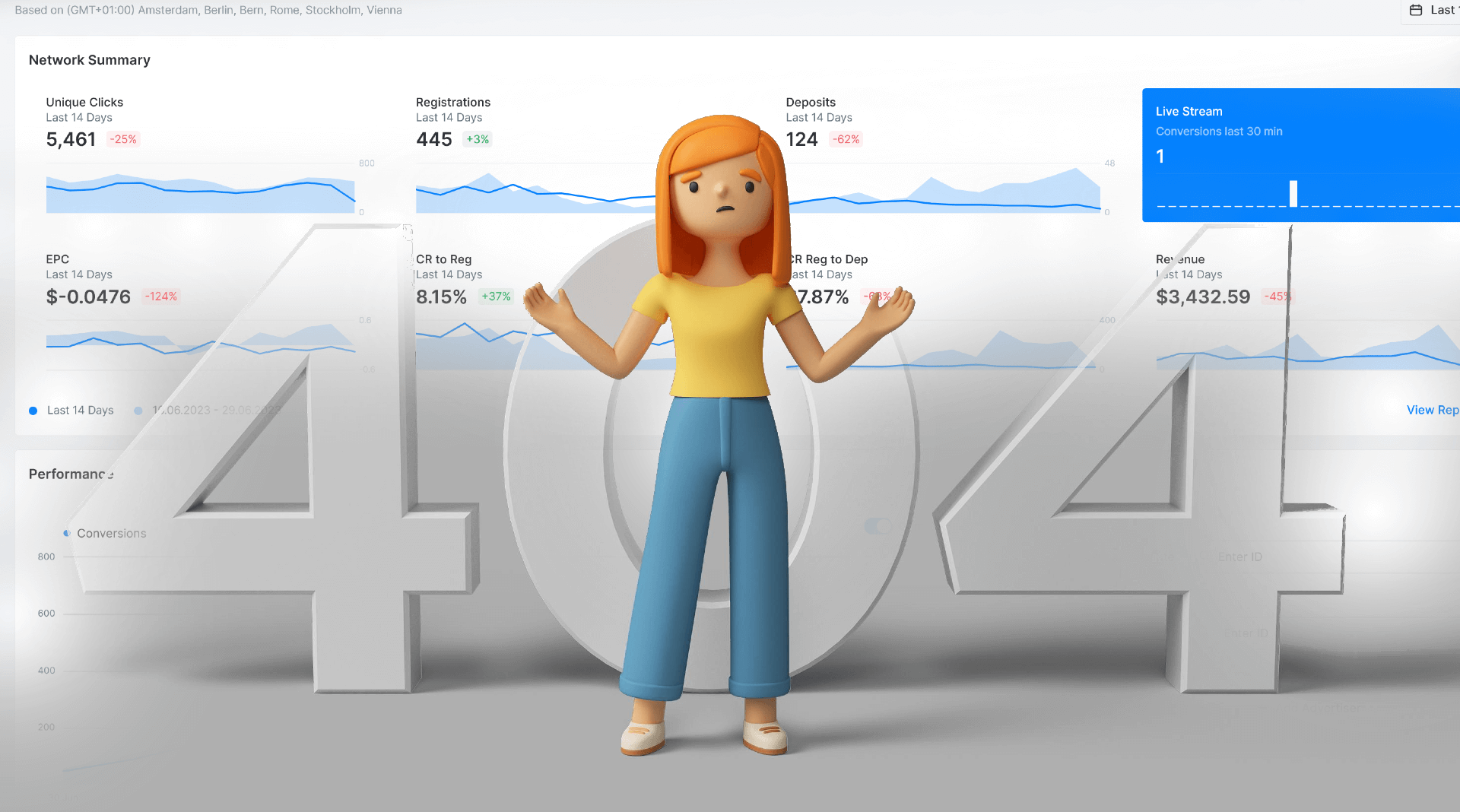The success of an iGaming platform is not solely determined by its user interface, game selection, or payout ratios. It hinges on the seamless interplay between various software components—especially when it comes to integrating with affiliate marketing solutions.
API integrations enable these separate systems to “speak” to each other, synchronizing data and automating critical processes that drive growth and profitability. When this delicate symphony of digital interaction performs flawlessly, it results in an enhanced user experience, optimized marketing strategies, and, ultimately, a boost in revenue.

However, what happens when the music stops? Suddenly, your meticulously planned affiliate campaigns are off-kilter, real-time tracking is disrupted, and, worst of all, your revenue might take an unfortunate dip.
You’re left with a digital mess that requires immediate attention and remediation.
Given the complexities and many variables involved, troubleshooting a failed API integration between your iGaming platform and affiliate software can be daunting.
But fear not.
This guide aims to serve as your comprehensive playbook for diagnosing and resolving these hiccups effectively. We’ll arm you with the knowledge, tools, and strategies you need to not only identify issues but also to tackle them head-on, minimizing downtime and maximizing operational efficiency.

Consider it your roadmap to navigate through the maze of API integration challenges, leading you toward a more stable, reliable, and profitable iGaming operation.
API Errors: HTTP Status Codes Overview
Before we dive into the specific errors, let’s start with a quick overview of HTTP Status Codes. These codes are the server’s way of communicating with you, the API user, about the status of your request.
If the status code falls between 200 and 299, it means the API call was successful.
However, if there’s an error, you’ll receive a 4xx or 5xx status code.
4XX Status Codes – Client’s Error
The 4xx status code indicates that the client (you) has sent a request that the server couldn’t process correctly. It’s an indication that there was an issue with the request itself.
5XX Status Codes – Server Error
On the other hand, the 5xx status codes indicate that the server encountered an unexpected condition that prevented it from fulfilling your request. This means that there’s an issue on the server’s end.
Now that we’ve covered the basics of HTTP status codes, let’s explore some common API errors and how to troubleshoot them.
Identify the Symptoms: Common API Errors and Troubleshooting Them
The first step in diagnosing a failed API integration is to identify the specific symptoms disrupting your system. This essentially means understanding the error messages that you encounter. Error messages aren’t merely roadblocks; they are signposts guiding you toward the root cause of the problem.
Below, we have listed all the common API errors, breaking down what they generally signify and how they can be addressed.
Let’s delve into each of these API errors and provide a comprehensive explanation of what they indicate and the necessary steps to take in order to fix them.
400 Bad Request Error
What It Means:
The server couldn’t understand your request due to invalid syntax, possibly because of incorrect data formatting or invalid parameters. This is a frequent error in form submissions and data exchanges between the iGaming platform and the affiliate software.
Troubleshooting Steps:
- Double-check your API payload structure; make sure it’s in line with the affiliate software’s requirements.
- Validate parameters: ensure that the required fields are filled and the types match (e.g., string vs integer).
- Consult API documentation to ensure you’re using the correct endpoints.
What It Means:
The 401 Unauthorized Error occurs when the server cannot authorize the user’s credentials. This error could be due to an incorrect username or password, or it may indicate a lack of permission access. It’s common when API keys or tokens are missing, incorrect, or expired.
Troubleshooting Steps:
- Confirm that you’re using the correct API key or token.
- Check the expiration date if using temporary tokens.
- Verify that the API key has the necessary permissions to access the desired resources.
403 Forbidden Error
What It Means:
The 403 Forbidden Error happens when the server refuses to fulfill a request from the client due to authorization limitations. This error indicates that the server recognizes your request but denies access. Even though your request is valid, you cannot access the resource. This often relates to permission settings.
Troubleshooting Steps:
- Double-check permission settings in both the iGaming platform and the affiliate software.
- Ensure that the account connected to the API key has adequate permissions.
404 Not Found Error
What It Means:
The server couldn’t find the requested resources. This could mean a wrong URL or an outdated resource ID. The 400 Bad Request Error is a commonly encountered API error that occurs when the server cannot parse the request. There could be several causes for this error, such as an incorrect URL, issues with the request composition, or problems within the application itself.
Troubleshooting Steps:
- Confirm the URL in your API request.
- Make sure you’re pointing to a resource that actually exists—like a specific campaign or user ID.
408 Request Timeout Error
What It Means:
The 408 Request Timeout Error is an HTTP status code that occurs when a server takes too long to respond to a client’s request. This can happen for various reasons, such as network congestion or the server overloaded with requests. When this error occurs, it means that the server did not receive a complete request from the client within the specified time limit.
In other words, your request took too long to process, possibly due to server overload or a slow network.
Troubleshooting Steps:
- Investigate the server’s performance metrics for bottlenecks.
- Optimize the request by limiting payload size or reducing the number of API calls.
405 Method Not Allowed Error
What It Means:
The server encountered an error while processing the request. The HTTP status code 405 Method Not Allowed indicates that the method used in the request is not supported for the requested resource.
Troubleshooting Steps:
- Check your API documentation to verify which HTTP methods are supported for your particular request.
- Please ensure that the correct HTTP method is used and try again.
- Ensure that you’re not using a method like
PUTorDELETEwhen the API expectsGETorPOST.
406 Not Acceptable Error
What It Means:
The request sent is not acceptable and cannot be processed by the server. Please review the request and ensure that the necessary parameters are included.
Troubleshooting Steps:
- Review the
Acceptheaders in your API call. - Double-check if the API supports the media types listed in your
Acceptheader.
409 Conflict Error
What It Means:
The 409 Conflict HTTP error occurs when there is a conflict between the request and the server’s current state. This error indicates that the server cannot fulfill the request due to a conflict, such as a version mismatch or a resource being accessed by multiple users simultaneously.
Troubleshooting Steps:
- Check for duplicate data or conflicting operations.
- Read any
“reason”or“message”fields in the API response for clues on what is causing the conflict.
410 Gone Error
What It Means:
The 410 Gone HTTP error indicates that the requested resource is no longer available on the server. This error code differs from the more commonly seen 404 Not Found error, as it specifically signifies that the resource has been intentionally removed and will not return.
Troubleshooting Steps:
- Verify the URL.
- Consult API documentation to check if the resource endpoint has been deprecated or moved.
- Revise the URL or contact the website administrator for further assistance.
411 Length Required Error
What It Means:
The server requires the request to be conditional, often requiring a Content-Length header. This is indicating that the request made by the client did not include the necessary Content-Length header specifying the length of the requested resource. This error occurs when the server expects a specific length of data to be included in the request, but the length information is missing.
Troubleshooting Steps:
- Ensure your request includes a
Content-Lengthheader with the length of the request body. - Check the API documentation for required headers.
412 Precondition Failed Error
What It Means:
The 412 Precondition Failed Error occurs when a request made to a server fails to meet the required preconditions specified by the server. This error typically happens when the client’s requested headers are missing or contain invalid values, or when the server’s expectations are not met. It is important to ensure that all necessary conditions are met before requesting to avoid encountering this error.
Troubleshooting Steps:
- Review your headers for conditions such as
If-MatchorIf-None-Match. - Check that your preconditions match the state of the resource you’re requesting.
413 Payload Too Large Error
What It Means:
The 413 Payload Too Large Error occurs when the size of the data being transferred exceeds the maximum limit set by the server. This error is commonly encountered in HTTP protocols, where the server may reject the request due to the large size of the payload.
Troubleshooting Steps:
- Reduce the size of the request payload.
- Check if the API has a size limit specified in its documentation.
- Check the size of the payload and ensure it falls within the acceptab
414 URI Too Long Error
What It Means:
The 414 URI Too Long Error is an HTTP status code that occurs when the Uniform Resource Identifier (URI) provided in the request exceeds the maximum length allowed by the server. This error is typically encountered when a client, such as a web browser, attempts to access a webpage or resource using a URL that is too long for the server to process.
When this error happens, the server responds with the 414 status code to indicate that the request cannot be completed due to the excessive length of the URI.
Troubleshooting Steps:
- Shorten the URI.
- If you’re sending a lot of data as query parameters, consider changing the request from a
GETto aPOST.
415 Unsupported Media Type Error
What It Means:
The 415 Unsupported Media Type Error is a response status code that occurs when the server refuses to accept the request because the media type sent by the client is not supported or not allowed for the requested resource. This error typically indicates that there is a mismatch between the content type specified in the request headers and the media type that the server is able to process.
Troubleshooting Steps:
- Verify that the
Content-Typeheader is correct. - Check the API documentation to find out which media types are supported.
416 Range Not Satisfiable Error
What It Means:
The 416 Range Not Satisfiable Error pops up when the server cannot fulfil the requested range of a resource. This error message is typically seen in response to a partial GET request, where the client is attempting to download only a portion of a file. The server may be unable to provide the requested range for various reasons, such as the range being outside the permissible boundaries or the server not supporting partial content retrieval.
Troubleshooting Steps:
- Validate your range headers.
- Consult API documentation to check if range requests are supported and how they’re implemented.
417 Expectation Failed Error
What It Means:
The 417 Expectation Failed Error occurs when the server is unable to meet the expectations set by the client in the request header. This error is often encountered when the client expects a certain behavior or outcome from the server, but the server cannot fulfill those expectations.
Troubleshooting Steps:
- Remove the
Expectheader from your request. - Consult the API documentation for the specific expectations the server can handle.
429 Too Many Requests Error
What It Means:
The 429 Too Many Requests Error is a status code that indicates the user has sent too many requests in a given amount of time. This error message is commonly encountered when a client exceeds the rate limit set by the server. It serves as a way for the server to protect itself from being overwhelmed by an excessive number of requests.
Basically it means that the user has sent too many requests in a given amount of time (“rate limiting”).
Troubleshooting Steps:
- Slow down your requests and respect the API’s rate limit
- Implement retry logic in your integration.
What It Means:
The 451 Unavailable For Legal Reasons error indicates that the requested resource is not accessible due to legal restrictions. This error code was introduced to highlight situations where access to a webpage or resource is prohibited by law. It serves as a reminder that certain content may be blocked or restricted based on legal obligations.
Troubleshooting Steps:
- Verify if the resource you’re trying to access is subject to legal restrictions.
- Consult API documentation for further information.
500 Internal Server Error
What It Means:
The 500 Internal Server Error is an HTTP status code that indicates a problem with the server, preventing it from fulfilling the request made by the client. This is a generic error message that does not provide specific details about the exact nature of the problem. The server error can occur for various reasons, such as misconfiguration, software bugs, or server resource issues.
This is a catch-all error indicating that the server encountered some unexpected condition.
Troubleshooting Steps:
- Check server logs for clues on what went wrong.
- If the error persists, it might be time to contact the affiliate software support team.
501 Not Implemented Error
What It Means:
The 501 Not Implemented Error is an HTTP status code that indicates that the server does not support the functionality required to fulfill the request made by the client. This error is typically encountered when the server receives a request for a method or resource that it does not recognize or is not capable of handling. It is important to note that this error is not the same as a 404 Not Found error, which indicates that the requested resource could not be found on the server.
Troubleshooting Steps:
- Check the API documentation to confirm if the endpoint and method you’re using is actually implemented.
- Consider contacting the API provider for more information.
502 Bad Gateway Error
What It Means:
The 502 Bad Gateway Error is a status code indicating a problem with server communication. This typically occurs when a server acting as a gateway or proxy receives an invalid response from an upstream server. This error can be caused by various factors, such as network connectivity issues, server overload, or misconfigured server settings. One server received an invalid response from another server it was communicating with. Most typically it happens when a proxy is involved.
Troubleshooting Steps:
- Check the status of intermediary servers or proxies.
- Validate that the destination server is up and running.
What It Means:
The 503 Service Unavailable Error is a common HTTP status code that indicates the server is temporarily unable to handle the request. This error message is typically displayed when the server is undergoing maintenance, experiencing overload, or encountering some other issue that prevents it from fulfilling the client’s request.
Troubleshooting Steps:
- Retry the request after a delay.
- Check the server status or maintenance schedule if available.
504 Gateway Timeout Error
What It Means:
A 504 Gateway Timeout Error occurs when the server, while acting as a gateway or proxy, is unable to receive a timely response from an upstream server. This error indicates that there is a communication issue between the server and the upstream server, resulting in a timeout.
Troubleshooting Steps:
- Same as 502, but with an added focus on diagnosing delays in the network or backend services.
505 HTTP Version Not Supported Error
What It Means:
The 505 HTTP Version Not Supported Error occurs when the server does not support or refuses to support the HTTP protocol version used in the request. This error is typically encountered when the client sends a request with an outdated or unsupported HTTP version, and the server cannot process it. It is important to ensure that both the client and server use compatible HTTP versions to avoid this error.
Troubleshooting Steps:
- Update your request to use a supported HTTP version.
- Check API documentation for details on supported HTTP versions.
507 Insufficient Storage Error
What It Means:
The 507 Insufficient Storage Error occurs when there is insufficient space to store the requested data. This error message is typically encountered when a user tries to save a file or download content onto a device with limited storage capacity.
It can occur on various platforms, including computers, smartphones, and tablets. When this error occurs, it serves as a reminder for users to free up space on their devices by deleting unnecessary files or transferring data to an external storage device. By doing so, users can ensure they have enough room to store their desired content and avoid encountering this error.
Troubleshooting Steps:
- Review storage utilization and allocate more resources if needed.
- Optimize data storage methods and purge unnecessary data.
508 Loop Detected Error
What It Means:
The 508 Loop Detected Error occurs when a request is trapped in an infinite loop, unable to break free and complete the intended action. This error is typically caused by a misconfiguration or error in the server or application, resulting in an endless loop that the system cannot escape from. When this error is encountered, it serves as a sign of a problem with the server’s ability to process and respond to requests effectively.
In other words, the server terminated the operation because it encountered an infinite loop while processing a request with “Depth: infinity”.
Troubleshooting Steps:
- Check for recursive API calls or infinite loops in your code.
- Consult the logs to pinpoint the loop and remove it.
Conclusion
The complexity of API integration between an iGaming platform and affiliate marketing software is not to be underestimated. Both systems are intricate, often requiring a meticulous approach to ensure smooth operation.
Successful API integration is more than just connecting two platforms; it’s about establishing a symbiotic relationship that enhances the functionality and profitability of both systems. Therefore, the importance of ongoing monitoring, regular updates, and timely troubleshooting cannot be overemphasized.
Have You Had Enough of API Errors in Your Affiliate Program?
If you’re looking to sidestep the labyrinth of API integration issues altogether, consider making the switch to Scaleo. With a focus on reliability and robustness, Scaleo offers a seamless integration experience, effectively mitigating common API errors.
Our software is engineered to handle the complexities so that you can focus on what truly matters: growing your business.

Your next step toward an error-free integration is just a click away. Make the wise choice; choose Scaleo.
Last Updated on March 19, 2024





